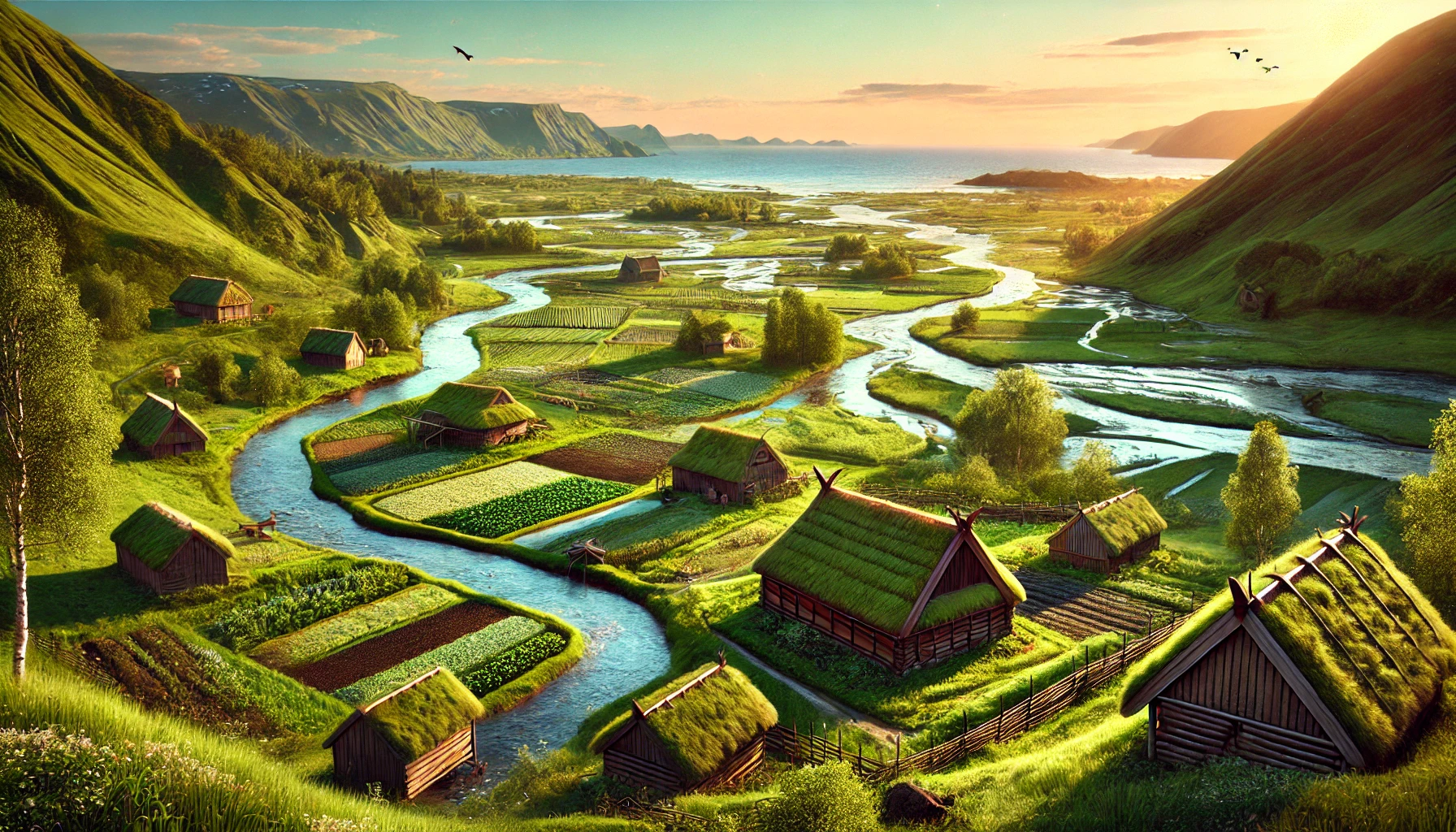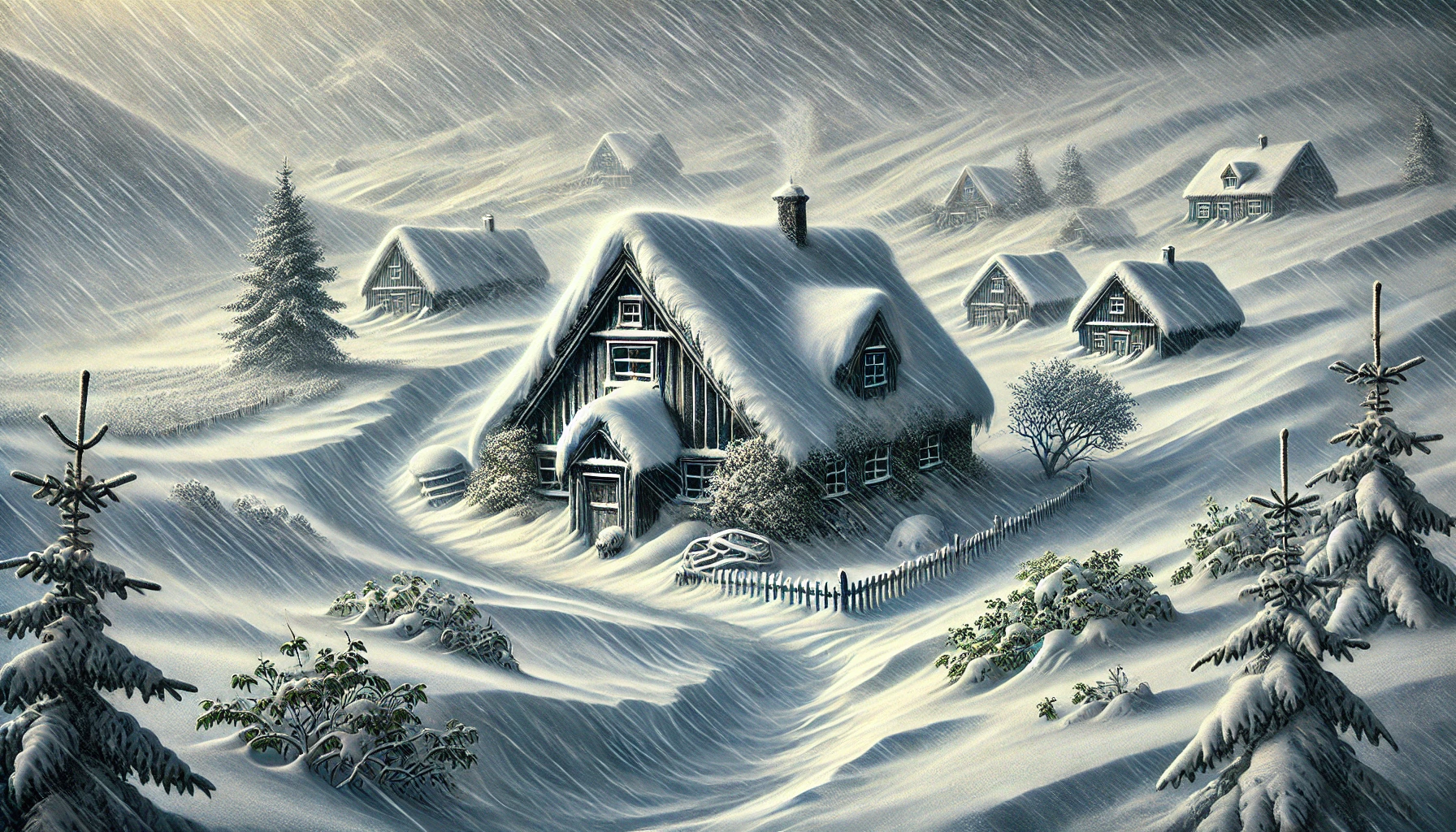[nord-holt]
1. Overview
Nordholt, nestled between the Turgu River and the icy expanses of the north, is a region of stark seasonal contrasts. Known for its rugged landscapes and divided into four distinctive subregions—Vestrack, Hafjord, Grenvik, and Austfjell—each area has developed unique traditions to cope with the harsh environmental changes. During the fertile summer months, these lands bloom with agriculture, supporting their inhabitants as they stockpile reserves for winter. When winter arrives, it brings a blanket of snow, transforming Nordholt into a realm of survival, where the inhabitants either migrate south or bunker down to endure the cold with their summer provisions.
2. Geography
Nordholt’s geography is profoundly influenced by the seasonal extremes, with its landscapes transforming dramatically from summer to winter. During the warmer months, the region is blessed with lush, fertile land, nourished by the nutrient-rich waters from the seasonal melting of the northern ice. This meltwater enriches the soil, fostering vibrant plant growth and providing excellent conditions for agriculture. The plains and valleys become verdant expanses, supporting the cultivation of a variety of crops and the grazing of large herds.

In contrast, winter transforms these same fertile lands into a stark landscape blanketed in snow. The once-thriving fields become frozen expanses, resembling white seas that stretch across the horizon. The severe drop in temperature and the covering of snow significantly alter the environment, challenging the inhabitants with a harsh, cold wilderness.

3. History
Historically, Nordholt served as a frontier for scientific exploration and experimentation, far removed from the conservative scrutiny of the Aegir Coast. It was here that cities of steam and iron once sprawled across the landscape, filled with scientists and engineers who delved into arcane projects that pushed the boundaries of knowledge and ethics. These workshop cities became hubs of radical innovation, exploring the deeper, often perilous mysteries of the world. Among those who worked in these experimental enclaves was the young wizard Raxenos, who later spark the downfall of these lands.
The unchecked progress and potential dangers emanating from these cities eventually led to a massive crusade by the Knights of FireOath, a militant order dedicated to purging heretical and dangerous practices. Their campaign scorched the land with fire, systematically destroying the workshop cities and purging the region of its avant-garde elements, shortly before the onset of the AoD. This fiery purge transformed Nordholt into a scarred land, marking the end of an era of industrial and arcane prosperity.
Today, Nordholt has transitioned dramatically from its industrial past. Now positioned on the cusp of habitable lands and bordering the frozen expanses, the region has become a rugged refuge where its people, far removed from their scientifically advanced predecessors, carve out a subsistence-based existence. The communities here have adapted to the stark contrasts between the fertile summers and the severe, snow-laden winters, developing a lifestyle deeply attuned to the rhythms of nature and the harsh realities of their environment.
4. Political Structure
Each subregion of Nordholt—Vestrack, Hafjord, Grenvik, and Austfjell—maintains its governance, tailored to their unique environmental and social challenges. Local leaders, often chosen for their experience and ability to lead during both the abundant and scarce seasons, govern with an emphasis on community resilience and adaptability. The regions cooperate on matters of mutual interest, such as defense and economic trade, but they also cherish their autonomy, celebrating their distinct identities and customs.
5. Economy
Nordholt’s economy is primarily driven by its seasonal agricultural activities. During the summer months, the fertile lands support a thriving agricultural sector, with inhabitants engaging in farming to stockpile food reserves for the harsh winter months. As the landscape transforms under the winter snow, the economy also shifts focus, with many residents adopting alternative means of livelihood, such as hunting or migrating to more hospitable areas for work.
Additionally, the economy of Nordholt is diversified through activities like mercenary work and the raiding expeditions of Hafjord. These ventures, particularly from Hafjord, bring wealth into the region, but they also complicate trade relations. Hafjord’s aggressive actions during the winter months have led to strained relations with nearby regions, including the Vindri of the Windswept Marches and several coastal cities along the Aegir Coast. As a result, Nordholt often finds itself relying on trade with more distant regions, navigating the delicate balance of fostering economic ties while managing the repercussions of its more belligerent subregions.
6. Culture and Society
The cultural life in Nordholt is as varied as its geography. Each subregion celebrates its own set of festivals and traditions that reflect their seasonal lifestyles. From the summer harvest celebrations to winter solstice rituals, these events are integral to the communal and spiritual life of the people. The harsh environment has fostered a strong sense of community and interdependence, crucial for survival. The reverence for elders and experienced leaders who guide their people through the seasons is a hallmark of Nordholt’s societal structure.
7. Military
Nordholt’s military structure is uniquely shaped by its geographic isolation and the varying temperaments of its subregions. The remoteness of the area means that Nordholt itself faces few external threats, leading to a military that is primarily offensive in nature. This setup allows for the aggressive pursuit of resources and territorial defense when required, rather than maintaining a standing force for homeland security.
In subregions like Vestrask, the military presence is minimal, reflecting the community’s more peaceful, survival-oriented approach and their reliance on the natural defenses provided by the terrain. Conversely, areas like Hafjord and Austfjell boast formidable military capabilities, distinguished not by cohesive strategic tactics but by the prowess of individual warriors. These fighters are celebrated for their personal strength and skill, qualities that are essential for the raiding and pillaging activities that these subregions are known for. Such a focus on individual martial ability over organized group tactics underscores a culture that values personal heroism and the capacity to survive and thrive in hostile conditions.
8. Notable Locations
- Vestrask
- Hafjord
- Grenvik
- Austfjell
9. Significant Characters
Introduce key figures associated with the region, such as rulers, heroes, or villains. Include brief descriptions of their roles and impacts on the region.
10. Current Issues and Future Prospects
Nordholt’s military structure is uniquely shaped by its geographic isolation and the varying temperaments of its subregions. The remoteness of the area means that Nordholt itself faces few external threats, leading to a military that is primarily offensive in nature. This setup allows for the aggressive pursuit of resources and territorial defense when required, rather than maintaining a standing force for homeland security.
In subregions like Vestrask, the military presence is minimal, reflecting the community’s more peaceful, survival-oriented approach and their reliance on the natural defenses provided by the terrain. Conversely, areas like Hafjord and Austfjell boast formidable military capabilities, distinguished not by cohesive strategic tactics but by the prowess of individual warriors. These fighters are celebrated for their personal strength and skill, qualities that are essential for the raiding and pillaging activities that these subregions are known for. Such a focus on individual martial ability over organized group tactics underscores a culture that values personal heroism and the capacity to survive and thrive in hostile conditions.
Lastly, establishing secure and reliable long-distance trade routes is essential for Nordholt’s economic diversification and sustainability. Given its isolated location and the strained relations due to raiding activities, Nordholt needs to forge alliances and trade agreements with distant regions to ensure a steady flow of necessary goods and to bring in additional revenue.